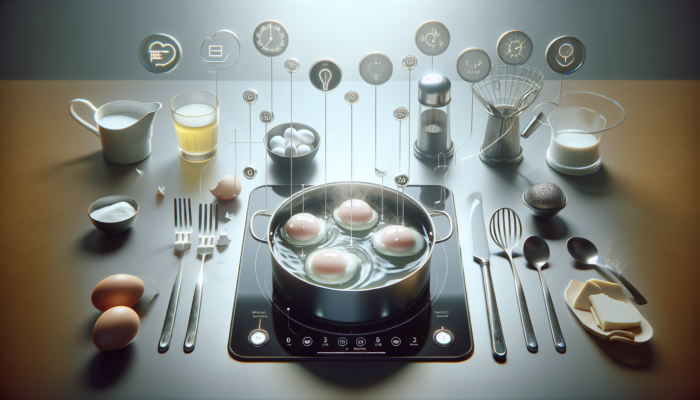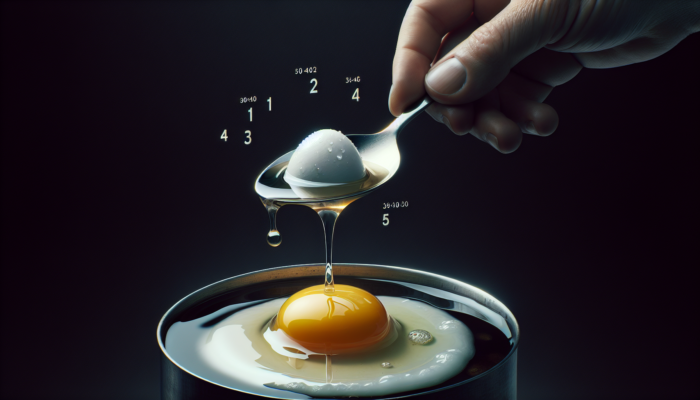Transform Your Breakfast: Master the Art of Poaching Eggs for Culinary Excellence
Acquiring the skill of poaching eggs is not only rewarding but also elevates simple breakfast dishes into gourmet experiences. Achieving the ideal balance of heat and timing is crucial for producing flawless poached eggs. This thorough guide will explore every essential element that contributes to poaching eggs perfectly, equipping you with the knowledge and techniques necessary for consistent and impressive results. Whether you’re just starting out in the kitchen or have years of cooking experience, this resource provides everything you need to create mouthwatering poached eggs that wow your guests and family alike.
Selecting the Best Eggs: Your Foundation for Perfect Poached Eggs

The journey towards crafting a remarkable poached egg begins with the careful selection of eggs from your local grocery store or farmers' market. It’s essential to recognize that not all eggs are created equal; their freshness and quality significantly impact your final dish. Freshly laid eggs possess tighter whites that maintain their shape during cooking. Upon cracking a fresh egg, you’ll notice the yolk sits higher, surrounded by firmer, less watery whites. This firmness is exactly what you desire for creating visually stunning and delicious poached eggs.
When choosing eggs, select those with clean, uncracked shells and a ‘best before’ date that is well into the future. Whenever possible, support local farms or trusted suppliers known for their exceptional egg quality. Generally, organic and free-range eggs are fresher, as hens raised in optimal conditions produce eggs with richer yolks and superior flavor profiles.
To summarize, the initial step in mastering how to poach an egg perfectly every time lies in selecting the finest eggs available. This crucial decision greatly influences your success, ensuring that your poached eggs are not only visually appealing but also packed with flavor.
Mastering Water Temperature: The Secret to Flawless Poaching
The temperature of the water is a pivotal factor in the poaching process that can greatly influence your outcomes. The ideal poaching temperature lies between 80 and 90 degrees Celsius (176 to 194 degrees Fahrenheit). Within this specific temperature range, the water is sufficiently hot to gently cook the egg without attaining a chaotic boil, which can create an uncontrollable cooking environment. Boiling water can cause the egg whites to move too energetically, leading to an unattractive appearance and uneven cooking.
To achieve the perfect water temperature, start by heating a pot of water until it is just below boiling. You should aim for a gentle simmer, where small bubbles appear at the bottom of the pot without breaking the surface aggressively. A thermometer can assist in accurately monitoring this temperature, but with practice, you’ll develop the ability to recognize the correct heat level through visual cues and sounds.
Once the desired temperature is reached, it's crucial to maintain it throughout the cooking process. If the water cools down, the egg will take longer to cook and may not achieve that sought-after silky texture. In contrast, if the water begins to boil, you must promptly reduce the heat. Mastering control over water temperature is fundamental in your quest to learn how to poach an egg perfectly every time.
Utilizing Vinegar: The Essential Ingredient for Perfect Egg Whites
Vinegar is frequently overlooked in the poaching process, yet it plays a vital role in ensuring your eggs achieve the desired texture. The acidity in vinegar accelerates the coagulation of proteins in the egg whites, helping to keep the egg intact and enhancing its overall consistency. This is especially crucial when using older eggs, as the whites typically lack cohesion compared to fresher ones.
When incorporating vinegar into your poaching water, aim for approximately one tablespoon per liter. While white vinegar is a common choice, apple cider vinegar can offer a milder flavor if preferred. It’s essential to ensure that the vinegar is well distributed throughout the water before adding your egg, as this prevents uneven clumping and encourages a uniform cooking process.
Though vinegar imparts a subtle flavor, when poached correctly, its taste should remain delicate and not overpower the egg's natural richness. Understanding the function of vinegar is crucial as you refine your technique for poaching an egg perfectly every time. This small addition can significantly enhance the quality of your poached eggs.
Comprehensive Step-by-Step Guide: Poaching Eggs Like a Pro

Adopting a systematic approach is vital for excelling at poaching eggs. With the appropriate tools, techniques, and timing, you can consistently achieve that perfect poached egg. Let’s outline a detailed step-by-step guide for this culinary adventure.
Organizing Your Workspace: Gather Essential Tools and Ingredients for Poaching Success
Before you dive into the poaching process, it’s crucial to organize your workspace. Collect all necessary ingredients and tools to ensure everything is easily accessible. To successfully poach eggs, you will need a pot, a slotted spoon, a timer, a bowl for cracking the eggs, and a thermometer for precise temperature monitoring.
Begin by filling your pot with sufficient water to fully submerge the eggs and place it on the stove. As previously mentioned, bring the water to the desired temperature. While waiting for the water to heat, prepare your eggs by cracking them into separate bowls. This technique simplifies the process of adding eggs to the pot and allows you to check for any shell fragments or spoiled eggs before cooking.
By organizing your workspace, you not only streamline the cooking process but also reduce the chances of making errors. Once you feel confident that everything is arranged correctly, you are ready to transition to the next stage of the poaching process.
Implementing the Swirling Water Technique: Achieve Perfectly Shaped Eggs Every Time
The swirling water technique is one of the most effective methods for poaching eggs. This technique creates a gentle vortex that helps keep the egg intact during cooking. Here’s how to perform it:
First, once your water reaches the ideal temperature, gently stir it with a spoon to create a whirlpool effect. This motion aids in guiding the egg whites around the yolk, promoting cohesion and ensuring a more uniform shape. Next, take your bowl with the cracked egg and carefully slide it into the center of the vortex.
Be cautious not to drop the egg from a height, as this can cause the whites to break apart. Instead, allow the egg to glide smoothly into the water. As the egg cooks, you’ll observe the whites enveloping the yolk, forming that signature poached egg appearance.
Maintain the gentle swirl for several seconds to help the egg set. The key is to move the water delicately without escalating to a vigorous boil. Perfecting this technique is essential for anyone aiming to master how to poach an egg perfectly every time, as it significantly enhances the presentation of the final dish.
Perfecting Timing: Discover How Long to Poach for Optimal Results

Timing is a critical element in achieving the perfect poached egg. Cooking time may vary slightly based on the egg's size and your preferred yolk consistency. Generally, poaching an egg for about 3 to 4 minutes will yield a runny yolk, while a firmer yolk may require up to 6 minutes.
To ensure consistency, start your timer as soon as the egg enters the water. For those who are new to poaching, utilizing a timer can be beneficial in preventing overcooking. When the time is up, gently lift the egg from the water with your slotted spoon and check for doneness. The whites should be set while the yolk retains a soft, slightly bouncy feeling to the touch.
If you occasionally overcook an egg, don’t be discouraged. Use this experience as an opportunity to fine-tune your timing for future attempts. With practice, you will develop an intuitive understanding of how long to poach for your desired level of doneness—an essential skill in how to poach an egg perfectly every time.
Removing and Draining: Techniques to Preserve the Shape of Your Poached Eggs
After achieving your desired cooking results, the subsequent step is to remove the eggs from the water without compromising their shape. This is where a slotted spoon becomes indispensable. Gently slide the spoon beneath the egg, ensuring you provide adequate support as you lift it out of the water.
Once the egg is lifted, draining excess water is crucial. To absorb moisture, place the egg on a plate lined with kitchen paper or a clean towel. This step is particularly important if you intend to serve the eggs on toast or in a dish where excess moisture could lead to a soggy texture.
For a more appealing presentation, consider trimming any uneven edges of the egg whites using kitchen scissors. This simple adjustment can enhance the visual appeal of your dish. By carefully removing and draining the eggs, you are well on your way to mastering how to poach an egg perfectly every time.
Avoiding Common Pitfalls: Expert Tips for Flawless Poached Eggs
Even experienced cooks can encounter common pitfalls when poaching eggs. Identifying these mistakes allows you to continuously refine your technique and achieve remarkable results. Let’s examine frequent errors and how to prevent them.
Preventing Overcooking: Identifying Signs and Implementing Solutions
Overcooking is one of the most prevalent mistakes made when poaching eggs. If you’ve ever encountered a rubbery texture or a yolk resembling that of a hard-boiled egg, you understand the disappointment it brings. The key to avoiding overcooking lies in closely monitoring both your timing and the water temperature.
To prevent overcooking, utilize a timer and check your eggs one minute earlier than you expect them to be done. Additionally, you can gently poke the egg with a spoon; it should feel firm yet have a slight give if it’s perfectly poached. If you frequently find your eggs overcooked, consider adjusting your heat settings or investing in a reliable kitchen timer.
Furthermore, due to residual heat, eggs continue cooking slightly even after being removed from the water. This is yet another reason to be mindful of your cooking times.
Maintaining Cohesion: Strategies to Prevent Egg Disintegration
Another common issue is egg disintegration, where the whites disperse in the water rather than remaining cohesive. This frustration often arises from using older eggs or excessively hot water.
To prevent disintegration, always choose the freshest eggs available. The tighter whites of fresh eggs hold their shape more effectively. If you must use older eggs, adding vinegar to the water can help tighten the whites and enhance their cohesion.
In addition, ensure that your water is at the correct temperature before introducing the egg. If the water is too hot, it can cause the egg to break apart. Utilizing the swirling method to create a vortex also assists in keeping the egg together during cooking. By being mindful of these factors, you can minimize the risk of egg disintegration and enhance your skills in poaching an egg perfectly every time.
Ensuring Uniform Cooking: Techniques for Consistent Results
Uneven cooking occurs when heat is not distributed evenly, or if there is insufficient water movement. If you notice that some parts of the egg are overcooked while others remain runny, it’s time to reassess your technique.
To combat uneven cooking, make sure your pot is large enough to allow for proper water circulation. A smaller pot can lead to overcrowding, which may result in inconsistent cooking. Additionally, maintain a gentle simmer and ensure that the water swells when adding the egg. This movement guarantees even heat distribution around the egg, leading to more consistent results.
By mastering these common mistakes, you can build your confidence in the kitchen and refine your ability to produce perfect poached eggs, reinforcing your understanding of how to poach an egg perfectly every time.
Elevate Your Poaching Game: Innovative Tools and Gadgets to Consider
The right tools can significantly influence your results in the pursuit of culinary excellence. While traditional methods can be effective, innovative gadgets can offer convenience and precision. Let’s explore some of these tools and assess their usefulness for your poaching endeavors.
Analyzing Egg Poachers: Are They Worth It?
Egg poachers are popular kitchen gadgets designed specifically for gently cooking eggs. They typically consist of a pan with inserts that hold the eggs above simmering water, creating a controlled cooking environment. This method can be particularly beneficial for those new to poaching, as it simplifies the process and minimizes the risk of errors.
However, while egg poachers may provide convenience, they might not offer the same level of control as traditional methods. The water temperature can fluctuate, and the eggs may not achieve that classic poached texture. An egg poacher can be an excellent tool for beginners to build confidence, but for those aiming to master how to poach an egg perfectly every time, it is advisable to learn the classic technique first.
Ultimately, the decision to invest in an egg poacher depends on your cooking style and how frequently you intend to prepare poached eggs. If you enjoy experimenting in the kitchen, it could be a valuable addition to your collection.
Using Silicone Cups: A Handy Solution for Aspiring Poachers
Silicone cups have recently gained popularity as a practical solution for poaching eggs. These flexible cups can be placed directly in simmering water, allowing for even cooking without the need for swirling. This method can be particularly advantageous for beginners who may find the swirling technique challenging.
To use silicone cups, lightly grease them to prevent sticking, crack an egg into each cup, and place them in a pot of simmering water. Cover the pot with a lid to trap heat and steam, resulting in perfectly poached eggs. The silicone material ensures easy removal and minimal cleanup, making them an excellent choice for busy mornings.
While silicone cups may not replicate the traditional poaching experience, they are a fantastic tool for those learning how to poach an egg perfectly every time. They provide a forgiving method that yields satisfying results without the stress of managing water temperature and swirling techniques.
Exploring Sous Vide: The Ultimate Precision Poaching Method
For those who desire the utmost precision in cooking, the sous vide method offers an innovative approach to poaching eggs. Sous vide involves vacuum-sealing food in a bag and cooking it in a water bath at a precisely controlled temperature. This technique enables you to poach eggs to your preferred level of doneness with minimal effort.
To sous vide poach eggs, set your immersion circulator to your desired temperature—typically around 63 degrees Celsius (145 degrees Fahrenheit) for a runny yolk. Place the eggs in their shells directly into the water bath and cook for about 45 minutes. The result is an egg cooked evenly throughout, boasting a silky texture that is hard to achieve through traditional methods.
While sous vide machines can represent a significant investment, they are an impressive option for those passionate about cooking and eager to experiment with precision. If you are serious about perfecting how to poach an egg perfectly every time, this method can elevate your culinary repertoire.
Showcase Your Poaching Skills: Delicious Recipes and Serving Ideas
Having mastered the essential techniques of poaching eggs, it’s time to showcase your culinary prowess with delightful recipes. Poached eggs are incredibly versatile, capable of enhancing an array of dishes. Let’s explore classic and modern serving suggestions that highlight the elegance of a perfectly poached egg.
Classic Eggs Benedict: A Timeless Brunch Delight
Eggs Benedict is arguably the quintessential poached egg dish, merging rich flavors with an elegant presentation. To prepare this classic, begin by toasting English muffins and layering them with crispy bacon or smoked salmon. Place a perfectly poached egg on top, letting the golden yolk cascade over the other ingredients.
For the finishing touch, whip together a homemade hollandaise sauce by whisking egg yolks, lemon juice, and melted butter until smooth and creamy. Drizzle the hollandaise over the poached egg and garnish with fresh herbs or a sprinkle of paprika for added color and flavor. This dish not only showcases your poaching skills but also creates a stunning centerpiece for brunch gatherings.
Eggs Benedict is a timeless dish that celebrates the delicate flavors of poached eggs while providing a satisfying meal perfect for any occasion. By mastering this recipe, you’ll take one step closer to mastering how to poach an egg perfectly every time.
Avocado Toast with Poached Eggs: A Modern Brunch Essential
Avocado toast has swiftly become a modern brunch favorite, and adding a poached egg elevates it to new culinary heights. To create this dish, start with a slice of artisanal bread, toasted to perfection. Mash ripe avocado with lemon juice, salt, and pepper, then spread it generously across the toast.
Top the avocado with a perfectly poached egg, letting the yolk break and mingle with the creamy avocado. Enhance the dish with toppings like feta cheese, cherry tomatoes, or a sprinkle of dukkah for an extra burst of flavor. This combination offers a delightful balance of textures and flavors while providing a nutritious meal.
Avocado toast with poached eggs is not only visually appealing but also an excellent way to incorporate healthy fats and protein into your diet. This dish exemplifies the versatility of poached eggs and their ability to enhance even the simplest of meals.
Poached Eggs in Soup: A Comforting and Luxurious Addition
Consider enhancing your favorite soup with poached eggs for a comforting and hearty option. The richness of the yolk can elevate the overall flavor of the dish while providing a satisfying element. Classic choices include ramen or minestrone, where the poached egg adds a touch of luxury.
To prepare, poach your eggs separately and carefully place them atop the soup before serving. The residual heat will warm the egg, allowing the yolk to remain runny while enriching the soup's flavor. This approach is an excellent way to display your poaching skills while creating a nourishing and comforting meal.
Incorporating poached eggs into soups not only adds depth but also transforms a simple dish into an elegant offering. By experimenting with various recipes, you'll continue to refine your understanding of how to poach an egg perfectly every time.
Expert Insights: Addressing Frequently Asked Questions and Pro Tips for Poaching Eggs
Can You Poach Eggs in Advance? Storage and Reheating Guidelines
Yes, you can poach eggs ahead of time! To store them, place the eggs in a bowl of cold water and refrigerate for up to two days. When you're ready to enjoy, reheat them in simmering water for about 1-2 minutes until they are warm and ready to serve.
How to Ensure a Consistently Runny Yolk
To guarantee a perfectly runny yolk every time, poach the eggs for 3-4 minutes at the correct temperature (80-90°C). Using fresh eggs will also help, as they maintain their shape better during the cooking process.
Poaching Multiple Eggs: Techniques for Maintaining Quality
When poaching several eggs, it’s advisable to do so in batches. Use a larger pot to provide ample space for each egg. Maintain a consistent water temperature and utilize the swirling method to prevent them from sticking together during the cooking process.
Can I Add Salt to the Water When Poaching Eggs?
While some chefs prefer to add salt to the water, it's generally advisable to avoid it, as it can cause the egg whites to break apart. Instead, season the finished eggs to taste after poaching for the best results.
How Do I Determine When My Poached Egg Is Done?
To check for doneness, gently press the egg; it should feel firm yet still have a slight give. Alternatively, you can cut into the egg to assess if the yolk is runny, depending on your preference for doneness.
What is the Best Pan for Poaching Eggs?
A wide, shallow pan is ideal for poaching eggs, as it allows for even water distribution. A non-stick pan can also be beneficial, helping to prevent the eggs from sticking and making removal easier.
Can I Freeze Poached Eggs?
Freezing poached eggs is not recommended, as the texture may change upon thawing. It's best to poach eggs fresh, although they can be stored in the fridge temporarily for convenience.
What Should I Do If My Egg Whites Spread Out in the Water?
If your egg whites spread, it may be due to using older eggs. Adding vinegar to the water can help coagulate the whites faster and keep them contained, thus preventing spreading during the cooking process.
Are Poached Eggs Healthy?
Yes, poaching eggs is a healthy cooking method, as they are prepared without added fats or oils. They are an excellent source of protein and essential nutrients, fitting seamlessly into various dietary plans.
Can I Poach Eggs in Flavored Broth?
Absolutely! Poaching eggs in flavored broth can enhance depth and elevate the overall taste of your dish. When adding the eggs, ensure the broth is at the correct temperature and not boiling for optimal results.
Connect with us on Facebook for the latest updates!
The post Poaching Eggs Perfectly: The Ultimate Aussie Guide appeared first on https://cookinggods.com
The Article Perfect Poaching Eggs: Your Ultimate Aussie Guide Was Found On https://limitsofstrategy.com

